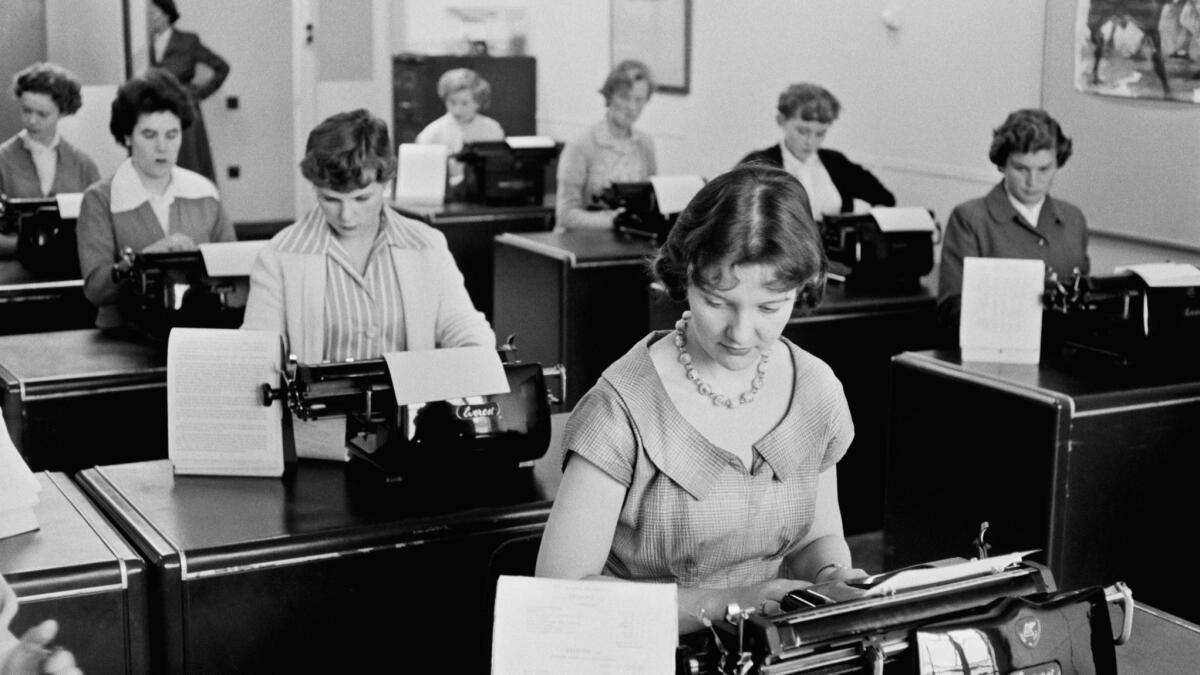Workplace equality won’t happen if women have to fight for it alone

- Share via
It started as a viral newspaper column in 2014, intended as a communication guide for men. Three years later, Joanne Lipman has turned her observations from the workplace and conversations with business leaders into a book — “That’s What She Said: What Men Need to Know (and Women Need to Tell Them) About Working Together.”
It’s being published just as the nation is grappling with the aftermath of the #MeToo movement and the systemic issues that have long plagued women.
Those issues, she said, are “the things [women] experience multiple times every day, like being interrupted, overlooked, marginalized, underpaid and simply not getting the same respect as the man sitting right next to us.”
The Times spoke with Lipman, the former editor-in-chief of USA Today, about lessons and strategies.
Let’s start at the beginning.
“Mothers of infants routinely overestimate the crawling abilities of their sons, but underestimate the crawling abilities of their daughters,” Lipman said. “Parents of 2-year-olds who type into Google, ‘Is my child a genius?’ are more than twice as likely to type that in about a boy 2-year-old than a girl 2-year-old.”
The culprit is unconscious biases “hidden so deeply within us we don’t know it exists,” she said.
Lipman found teachers also acted on those biases. In one study, a group of elementary school kids took a math test. With no names on the test, the girls scored higher. With names put on, the boys scored better.
“It just showed you there was this unconscious bias the teacher had that boys are better at math. You would think that math is black and white and that should not be the case, but that’s what happens.”
Lipman traced the research up until college.
“A female student needs to have an A-average to be seen as the equal of a male student with a B-average. That research shows that by the time we even hit college, much less the workforce, we have already internalized that women are worth less than men.”
Biases have an effect.
Lipman cites a study in which a group of 6-year-olds were told to do a simple task and pay themselves in Hershey’s Kisses. The boys paid themselves more. The exercise was repeated in middle school and high school – this time with money – and the results were similar.
“It suggests that we all value women less than men. But also, when you value us women less, our contributions are also valued less.”
This may also suggest that by the time a woman gets into the workforce, her self-perception of her monetary value has already been shaped by years of misjudgment and further cemented by a pay gap. Women on average make 80 cents on the dollar compared with men. Black women make 63 cents on the dollar and Latina women make 54 cents on the dollar.
Yes, women do get interrupted more than men.
Whether you’re at the start of your career or an established Supreme Court justice, Lipman said that women are likely to be interrupted more than three times as often as men. What’s more, often when a woman isn’t interrupted, a man shares a similar idea and gets the credit.
Lipman found some executives who have successfully worked to combat the problem. Here’s how:
- Re-attributing an idea to the woman it originated with when it’s later raised and repeated by someone else during a meeting.
- Set a “no interruptions” rule. A producer on “The Shield” realized that the women writers couldn’t get their ideas across because the men would interrupt. He enforced a policy that ensured people were given time to finish their pitch.
Cultural change has to come from the top.
A company can’t rely solely on its human resources department to change its culture. That responsibility must fall to top leadership to internalize those changes, and set a new standard.
“They need to own this as their responsibility and if it fails, it’s their failure,” Lipman said.
In Silicon Valley, tech companies are holding unconscious-bias trainings and enforcing family-leave policies, but the messaging doesn’t align throughout the companies.
Apple’s headquarters has a wealth of amenities including a health and wellness center -- but no childcare on site, Lipman said.
At Google, Lipman spoke with a diversity and unconscious-bias expert who’s working to change the culture. But his mission seems to be at odds with the top brass at Alphabet – Google’s parent company. Lipman says the executive chairman referred to his ideal employee as being someone who works hard every day, goes home for dinner and jumps back onto the computer.
“Who’s going to win in that situation?” Lipman said. “It’s the leadership who changes the culture.”
Diversity makes for a better product.
“Single-sex groups are more comfortable, but they come up with the right solution less frequently because they’re just reinforcing each other,” Lipman said.
Lipman references an example about Kotex, the feminine hygiene business under Kimberly-Clark Corp. After a male executive pushed to bring more women into the leadership of the company, the newly diversified marketing team developed a much-talked about 2010 campaign dubbed “Apology,” which mocked previously tone-deaf ads.
“We’re just smarter and better when we have these mixed groups,” she said.
Twitter: @cshalby
ALSO:
Four female filmmakers lay out a road map for working toward gender equality in Hollywood
Women in their own words: Why we’re not working
More to Read
Inside the business of entertainment
The Wide Shot brings you news, analysis and insights on everything from streaming wars to production — and what it all means for the future.
You may occasionally receive promotional content from the Los Angeles Times.











